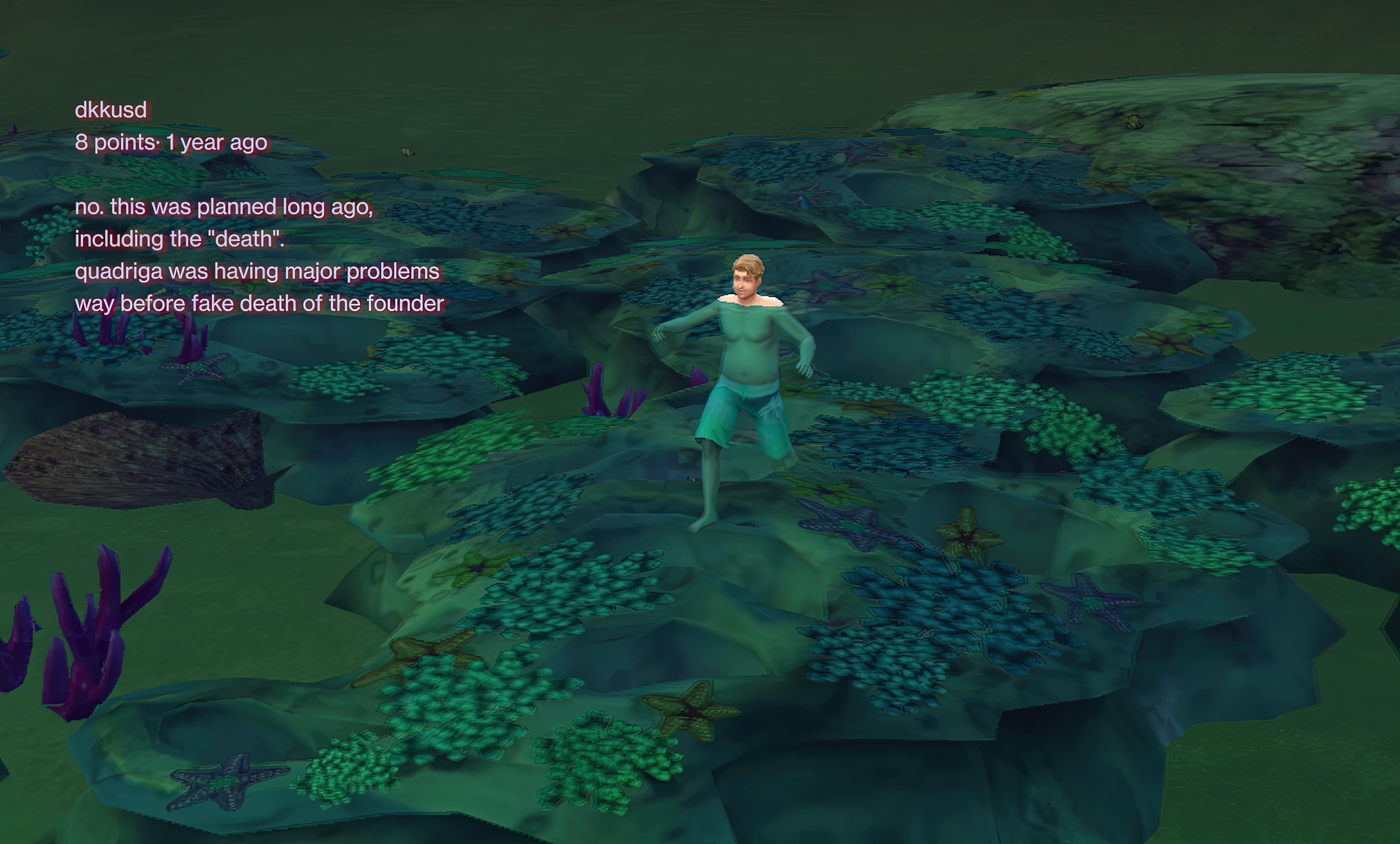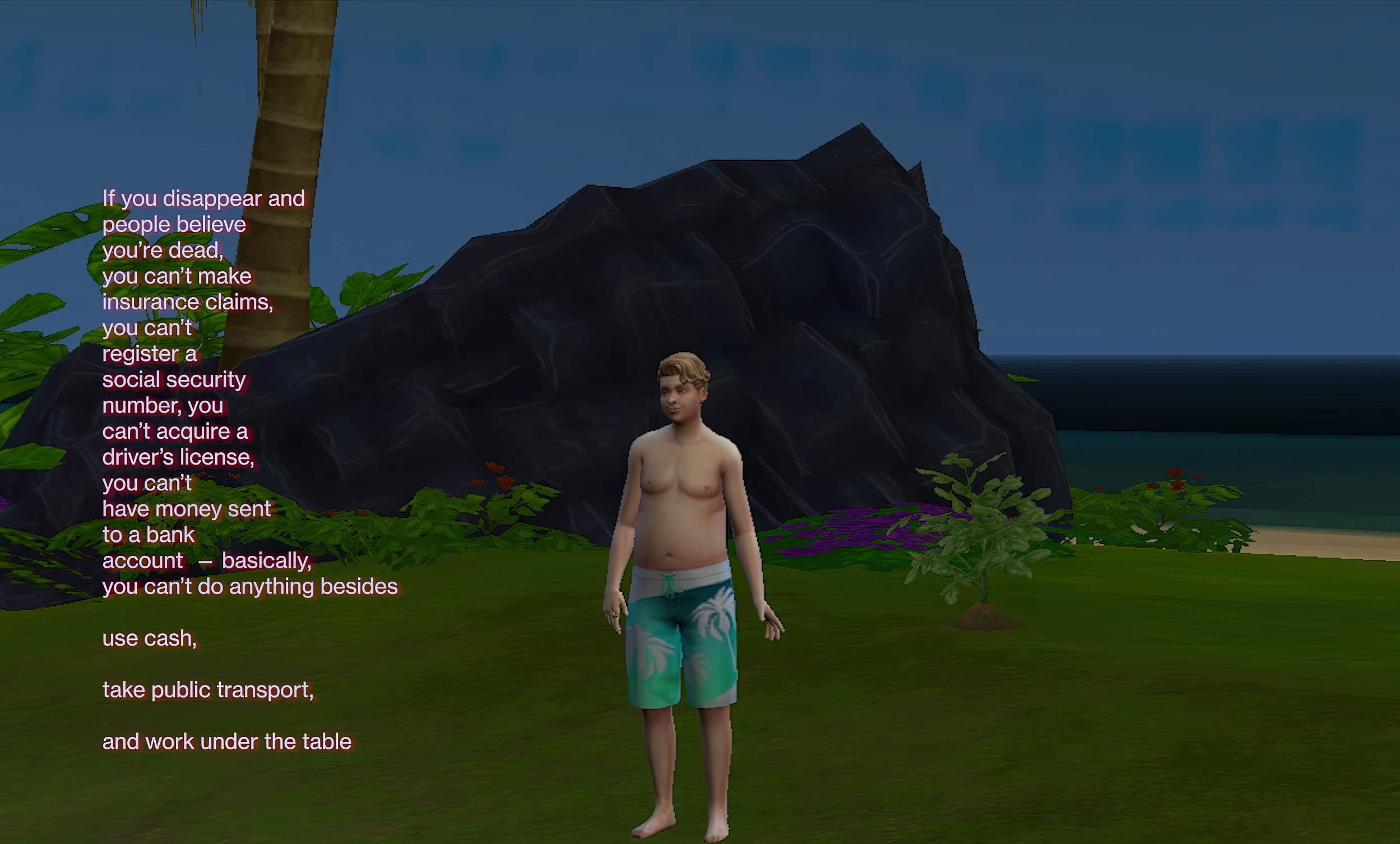CRYPTOHEAVEN3
digital video/machinima (1920 x 1080), color, sound, 5’ 39”, 2022, Ukraine
Created by Letta Shtohryn
Cryptoheaven3 (2022) is the third iteration of an ongoing project developed with The Sims 4 about the digital afterlife of Gerald Cotten, the CEO of QuadrigaCX, a popular cryptocurrency exchange. When Cotten unexpectedly passed away in 2018, he held the passwords to every customer's digital wallet, thereby rendering $190 million lost or missing. His mysterious disappearance sparked several conspiracy theories and marked the beginning of an online hunt for “the Truth”. Letta Shtohryn began exploring this event shortly after Cotten’s passing with Crypto H(e)aven (2019) and Cryptoheaven 2.0 (2020, in collaboration with curator Kat Zavada). The latest installment, Cryptoheaven3, is a hybrid of machinima and net.art combining The Sims 4, text messages, forum posts, and GIFs. Cotten is on a remote island enjoying the good life — sunbathing, getting daily massages, and imbibing exotic cocktails — while former QuadrigaCX users and conspiracy theorists speculate about his untimely demise.
Letta Shtohryn (Ukraine/EU) is an artist and researcher who works predominantly with media art, sculpture and imagery. She investigates the complex relationship between the physical and digital realm. She explores embodiment through a post-humanist lens, considering non-human life forms, machines, avatars, aliens, monsters, and ghosts. Being fascinated by deception, Letta also explores the relationship between fact and myth-making. Her methodical frameworks include speculative investigations, world building, and storytelling. Her tools feature virtual reality, augmented reality, textile, sculpture, video, machinima, and imagery. Her academic background is in Philosophy/Sociology (University of Vienna), Photography (Kunstschule Wien), and Digital Art (MFA/UM). Letta is the founder of digital platform Whatdowedonow.xyz and holds the position of Research Excellence Award Fellow at The Immersion Lab, University of Malta. Her work has been shown internationally.
Gemma Fantacci: Before They Delete This (2020) is the second installment of Cryptoheaven (2019), an artistic speculation about the digital afterlife of Gerald Cotten, the CEO of QuadrigaCX, a popular cryptocurrency exchange platform, who died in 2018. As you write in the accompanying text, “Cotten personally held the passwords to every customer's digital wallet, thereby rendering $190 million lost or missing. The mysterious death sparked a series of conspiracy theories and marked the beginning of an online hunt for the Truth”. The follow up to the original Cryptoheaven was developed in collaboration with artist and curator Kat Zavada. Can you elaborate on the genesis of the project? Why did you decide to further investigate Gerry Cotten’s story through a machinima?
Letta Shtohryn: The project actually had three parts to it. The first one is Crypto H(e)aven (2019) which consisted of an installation in the shape of a room with curtains, a screen with 12 minute video and a podium with chocolate bitcoin that the public was indirectly encouraged to take and consume. This was the first exploration of Gerry Cotten’s story that started a few weeks after his alleged death. The story is based on the whole trust element of crypto exchanges, which led to reflection on this almost religious quality of crypto currency that manifests in the belief of its realness strengthened by constant flow of investment in it (amongst other elements). These circular elements that strengthen the idea made me think of organized religion, or any kind of ideological human gathering, whether crypto enthusiasts or church goers.
In CryptoH(e)aven (2019), I imagined Gerry with changed identity and appearance, who moved to an island and hid amongst the digital nomads, while observing the investigation through the screen. So in this first iteration there is very little text but a visual speculation about his life amongst the nomads. In that speculation Gerry constantly changes his identity in the video, which gives him this mysterious character energy, but also a character that is in this nomadic limbo state full of leisure and senseless conversations. The video was a machinima work created with The Sims 4 which gave it its own sleek Sims-ish aesthetic as well as worked within game limitations.
As another year went on and there was still no resolution to the case, Reddit grew rich with testimonies and theories, so I created a new iteration of Gerry’s story, which is Cryptoheaven 2.0 (2020). Then, as a collaboration with Kat Zavada, I created a website that more richly engages with the text posts of Reddit, whether theories, testimonies, or investigation progress reports. The website became a work on its own and got the title Beforetheydeletethis (2020) that can be found here.
In this year’s iteration, Cryptoheaven3 (2022), the video and the website merge into one video work that became a sort of compilation between machinima and net art. The work presents three speculative story lines comprising two versions of Gerry living different lives: a secluded one and a social life, the latter under a new identity. The third storyline comprises text, gifs, and online evidence that shows other possibilities about what actually happened. They are aggressively overlaid on the machinima video and meant to distract but also to suggest other possible solutions. The video is also circular that when looped is supposed to suggest the nature of the online investigations but also of this case, that so far has not been resolved. This aesthetic reflects the salad of ideas and evidence that one drops into when one tries to make sense of the case. The GIFs of Gerry as manifested in The Sims 4 have also become objects on their own that I have been selling separately as editions on my website. This way machinima, website and the GIFs became a kind of transmedia presence of Gerry’s story through my works.
Gemma Fantacci: Both projects are remarkable as they provide a compelling narrative to navigate and make sense of the vast amount of information surrounding Cotten’s death. Every piece of the puzzle you included — videos, photos, texts, links — is an entry point into a vast universe of real or alleged connections — anhedonia is always behind the corner. The video perfectly recreates the state of mind associated with the frantic, often erratic search for “the truth” experienced by those who share or actively participate in conspiracy theories. What was the rationale behind the presentation of the content that you collected? How long did it take you to investigate the case and select the content?
Letta Shtohryn: The speculative elements of the story and lack of resolution was what attracted me to it. Since early 2019, I have been keenly observing the testimony of the people who lost all of their funds in Quadriga as well as the FBI investigations into Cotten’s death. Both strands have criss-crossed on Reddit; in fact, the FBI were looking for testimonies on Reddit and the Redditors were piecing together the events about Cotten’s death on their own, in an act of Internet sleuthing. As the story progressed and was getting no resolution, sometime in 2020 I returned to the project and started collecting the Reddit content, as well as images and posted data (such as GPS data from Gerry’s boat). Then some people reached out to me with more evidence on Gerry’s online life (this I have also dropped in the video and as an easter egg on the website) which kind of added the layers to the process/project.
As for organization of the content, the approach was twofold - the visual experience itself and the user experience (UX). The visual experience was inspired by early Internet chaos, conspiracy theories sites, and the general chaos of Reddit. So with typography, memes and gifs created from The Sims 4 I have suggested a visual experience that is kind of a multilayered chaos, but also segmented in chapters. The chapters can be experienced in a linear and nonlinear manner, i.e. in an absolutely non user-friendly way, which suggest more complexity to the website than there actually is.
Gemma Fantacci: The con artist is an emblematic character and not necessarily an emergent one. But today, she or he seems to thrive in the tech industry. A horde of con men and con women are constantly promising a revolution of some kind, and yet they rarely deliver. Some of the most outrageous characters of the past decade — from Elizabeth Holmes (Theranos) to Adam and Rebekah Neumann (WeWork), not to mention the vast majority of cryptocurrency evangelists — have eccentric personalities bordering on megalomania and even sociopathy. Why have techno-scammers become such prominent players today?
Letta Shtohryn: Crypto needs personalities, as it’s fundamentally dull and technology-centered. The tech can’t sell itself. So motivational speakers appear that are either like Carlos Matos (loud, fun, distracting) or quasi-economics nerdy (Holmes, Cotten). Long line of MLM schemes, Rich Dad, TV shopping channels, etc. Get in early, limited stock, FOMO. The people on both sides of the equation are the same, it’s just the object being sold happens now to be crypto.
Gemma Fantacci: I recently watched Luke Sewell's documentary Trust No One: The Hunt for the Crypto King on Netflix, and some of the interviewees made interesting remarks about the growing popularity of conspiracy theories. One of them, Andrew Wagner, argues that “Conspiracy theories breed in ignorance. It’s easier for people to draw wild speculations because the authorities are not quick enough to provide them with accurate information. ‘Cause if you force people on the internet to be detectives [...] they’re gonna solve it their own way’”. Wagner talked about the cryptocurrencies, but we’ve witnessed the same dynamics with the origin of Covid-19 and vaccines during the pandemic: those who hold scientific authority are not taken seriously or are seen as members of “the system”. Diverging, often contradictory interpretations proliferated. “Mainstream media are biased and cannot be trusted”. People are looking for quick answers on social media and fact checking is a chimera. Is it possible to teach a critical approach to information or the train has left the station a long time ago? Can artistic projects function as pedagogical tools? Can artists be trusted? What’s your take?
Letta Shtohryn: Generally via artistic methods one can research the same themes and more as via other methods. Research through art can offer different ways of understanding and exploring existing meanings, but also it can create new meanings and connections about existing issues, offering more knowledge acquired from a different perspective. So in that sense all art can serve as a pedagogical tool, but the difference to me is whether artworks are created with an aim to serve as pedagogical tools. I find that artworks don’t have to have a utilitarian purpose of teaching a lesson to be valued. It can be also done via other disciplines; design, for example. The artworks I like don’t teach me anything, they reveal something I haven't seen yet.
With my work I am not aiming at educating the viewers, I suggest a multitude of meanings and speculatively point to the direction i am going with it. Deliberately I have never taken a position that teaches the viewer something. I find it can be patronising and give off the energy of being talked down to. I believe the viewers have enough imagination to understand the work without the meaning being narrowed down to an educational agenda.
Gemma Fantacci: There’s another statement in Sewell’s documentary that got me thinking. One of Cotten’s customers/victims, Tong Zou, stated how his interest in cryptocurrencies came from a desire to become rich right away, because “Nobody wants to get rich slowly.” Cryptocurrency is often linked to the “quick and dirty money” narrative that leads to the “good life”: luxury cars, exotic vacations, fancy clothes. The victims of QuadrigaCX were crushed by a system bigger than themselves. Many of them probably did not even have the necessary know-how for dealing with cryptocurrencies. As they say, playing with fire can get you burned. How can images of the “perfect life” shared on Instagram or cleverly edited videos on YouTube fool us so easily?
Letta Shtohryn: I think here the two scales clash: the scale of ridiculous riches and the scale of small earnings on a daily basis, the first one and the second one are miles apart, that’s where the attraction comes in. It’s an attraction of something otherworldly, but one that is also mundanely possible.
People perhaps feel like it’s more possible to get rich through crypto than buying a lottery ticket, whilst also giving them a sense of agency that the luck of a lottery ticket doesn’t have. Choosing what to invest in, when to pull out, how to play the market – these are all active choices, although ultimately random ones; much as a novice gambler in a casino wins a few games, thinks they have found a system, only to leave at the end of the night with nothing. The gamification of crypto apps is also fascinating, encouraging what should be a considered investment to become more akin to rolling dice.
Gemma Fantacci: Your artistic research explores the mechanisms of control and access to information, the relationship between facts and deception, speculative investigation and storytelling. Where does your interest in this area of inquiry come from? Can you also address your decision to frequently use The Sims as part of your practice?
Letta Shtohryn: Using machinima aids speculative practices, but also because it’s in-game and bound to game interactions, it kind of runs off on its own based on game algorithms. My first machinima project was in The Sims 3, called Algorithmic Oracle (2019). The work integrated the unpredictability of The Sims 3 into it conceptually, as it explores alternative realities to a real world house fire event which I recreated in The Sims 3.
In the game I created a set of initial interactions (an avatar lights a fire in the fireplace and goes to sleep) and I have let the game take its course with its semi random fire algorithm. The majority of the interactions resulted in different outcomes. The number of final videos and the alternative realities they offered were also interpreted as algorithmic bubbles we consume our social media through, providing us with our own course of reality. For that project I chose The Sims 3, as the avatars in the game have more agency than in later versions of the games.
It’s possible to recreate the visual aesthetics of The Sims 3 or The Sims 4 in the Unreal game engine, but my machinima works are not about the sleek 3D look when I utilize The Sims. In my works, I’m attracted to worlds programmed by someone else, the unpredictability of the gameplay when left unchecked, and all sorts of chaotic randomness that might or might not occur.
In Crypto H(e)aven (2019) and (2020), I used the look and the gameplay together for speculative storytelling. Unlike Algorithmic Oracle, Crypto H(e)aven did not rely on the randomness of the game, but the work materialized through The Sims 4. The game’s elements, such as the avatar’s personality and subsequent gestures and interactions, added to the speculation.
Gemma Fantacci: I recently discovered Molly White’s blog, Web3 is going just great. The young software engineer collects cases of fraudulent companies like QuadrigaCX. I found it very helpful in navigating this wide ocean of information that is not easy to understand. In one of her posts, White states that the traditional media are not without blame, having created a type of narrative around bitcoins by portraying them as a groundbreaking innovation while failing to point out the potential pitfalls as well. She writes: “Most of my disdain is reserved for the big players who are marketing this to a mainstream audience as though it’s an investment, often promising to be a ticket out of a really tough financial spot for people who don’t have many options”. Are you familiar with her critique of cryptocurrencies? What do you think of the role of the media in discussing cryptocurrencies?
Letta Shtohryn: Yes I am familiar with Molly White’s blog, it’s great. She’s this crystal clear voice of realism amongst the murky promises of Web3. Since the recent crash crypto currencies in the media have been discussed with this almost gloating “we told you so” tone. I don’t know, some people lost thousands, these voices are also everywhere on the Internet and this crash might influence the readiness of the trust in crypto in the future.
Gemma Fantacci: A similar approach has been reserved for NFTs, treated as an opportunity for emerging artists to enter the art market and a fruitful investment for aspiring collectors of digital art. Actually, the matter is far more complex, but such publicity, also endorsed by exhibitions such as the recent event at Palazzo Strozzi in Florence in which NFTs are described as “a movement in the grip of evolution and transformation”, certainly does not help to address the issue objectively. What’s your take on NFTs?
Letta Shtohryn: I am more inclined to believe that NFTs are a funny fad that won’t last. I wish they’d offer better art. But wait they don’t offer art (in most cases), just some ledger and create fresh space for money laundering. But hey, if an artist wants to sell NFTs and support their practice, they should go for it.
CRYPTOHEAVEN3
digital video/machinima (1920 x 1080), color, sound, 5’ 39”, 2022, Ukraine
Created by Letta Shtohryn, 2022
Courtesy of Letta Shtohryn, 2022
Made with The Sims 4 (Maxis, Electronic Arts, 2014)
















